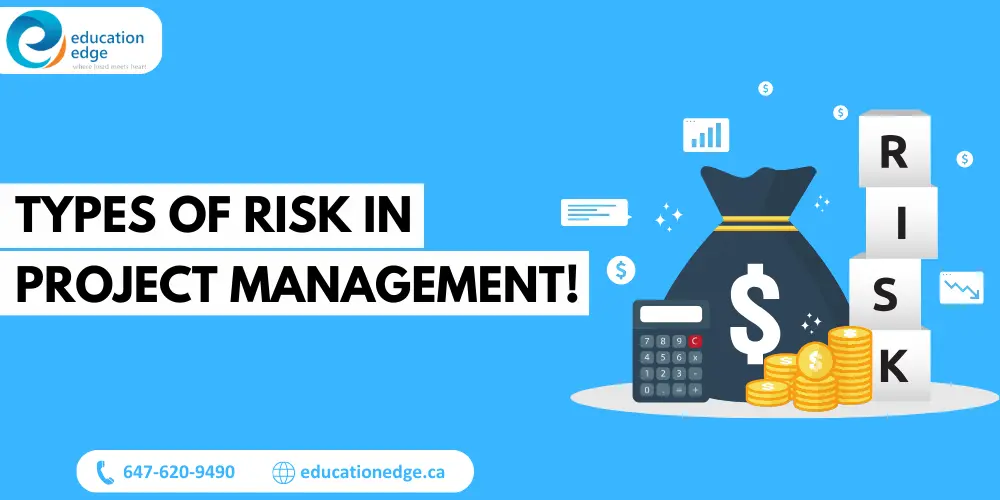
Understanding the Types of Risk in Project Management such as cost risk, schedule risk, operational risk, technology risk etc are essential for project management professionals to identify, assess, and mitigate risks that can influence the project’s outcome.
Therefore, risk refers to the possibility of an event or condition that can have a negative or positive impact on a project’s objectives. While not all risks are harmful, project managers are primarily concerned with identifying and mitigating risks that could prevent the project’s success.
What is Risk in Project Management?
In project management, risk refers to any incident that can have a positive or negative impact on your project. Risk management deals with detecting and dealing with these events before or during their occurrence. Risks can occur in many forms, such as employee illness, bad weather, additional costs, or transportation delays.
Types of Risk in Project Management
Here are the list of common Types of Risk in Project Management:
1. Cost Risk
2. Schedule Risk
3. Performance Risk
4. Operational Risk
5. Technology Risk
6. Strategic Risk
7. Communication Risk
8. Scope Creep Risk
9. Skills Resource Risk
10. Governance Risk
Cost Risk:
Cost risk relates to potential of exceeding the project budget due to unforeseen expenses, fluctuations in economic conditions, or budget constraints.
Schedule Risk:
Scheduled risk involves the chances of not meeting project deadlines because of unexpected delays, resource unavailability, or dependencies on other projects.
Performance Risk:
It refers to the risk of not achieving the project’s desired level of quality or output, which can impact project success and stakeholder satisfaction.
Operational Risk:
Operational risk refers to disruptions caused by internal processes, such as resource mismanagement, inefficient procedures, or breakdowns in project operations.
Technology Risk:
It is associated with issues such as software flaws, hardware failures, or compatibility issues that may impede the project’s usage of technology.
Strategic Risk:
Strategic risk involves external factors like shifts in market conditions, competition, or regulatory changes that can affect a project’s alignment with its strategic objectives.
Communication Risk:
It refers to problems in conveying information within the project team or with stakeholders, which can lead to misunderstandings and errors.
Scope Creep Risk:
Scope creep risk is the potential for uncontrolled expansion of project requirements or objectives, which can lead to increased costs and delays.
Skills Resource Risk:
It involves issues related to staffing, such as skill gaps, inadequate staffing levels, or the availability of necessary expertise.
Governance Risk:
Governance risk is linked to challenges in project oversight and decision-making, including issues like poor project leadership or a lack of clear governance structure.
How to Handle and Avoid the Risk?
There are the following ways that will help you to handle and avoid types of risks in project management:
1. Early Risk Identification with a Risk Register
Consider using a risk register to handle future challenges in advance. It is an essential risk management tool that is implemented from the beginning of the project. This register identifies risks, analyzes their severity, and describes mitigation strategies for dealing with them.
2. Utilize Project Management Software
Using project management software helps to streamline processes, improve comprehensive planning, and provide understanding of difficulties and risks.
It is an excellent choice for risk management because it enables proactive problem-solving, especially when combined with a risk register.
3. Prioritize Risk
After identifying common risks, it is essential to prioritize them based on your business needs. Hence, this involves focusing on the most urgent risks, like cost and legal risks, while delaying others that can wait.
4. Connecting Risk Probability to Impact
A critical part of risk management is associating the chance of each risk with its potential effects. The “probability” denotes the chance of a risk occurring, but the “impact” denotes the seriousness of the consequences if the risk occurs.
Tools of Risk Management
Here are some commonly employed project risk management tools:
- Risk Register: A document including descriptions, impact assessments, and potential mitigation solutions for identified project risks.
- Risk Assessment Matrix: A grid helping in risk prioritization based on the scale of low, medium, or high chances and impact.
- Probability and Impact Matrix: A tool for evaluating the chances and potential consequences of risks on the project.
- SWOT Analysis: A framework for assessing project strengths, weaknesses, opportunities, and threats, helping to identify risks and opportunities.
- Brainstorming: A technique for creating risk ideas that encourages open discussions and creative thinking.
- Delphi Technique: A strategy for gathering and collecting expert opinions on potential project risks.
- Monte Carlo Simulation: A statistical approach for modeling and simulating potential project risks and their impact on project outcomes.
Take your risk management skills to the next level with our PMI-RMP Certification, designed to help you effectively identify and mitigate risks in projects.
Frequently Asked Questions
1. What is project risk?
ANS: Project risk refers to any uncertain event or condition that can have a positive or negative effect on a project’s objectives.
2. What are the primary types of risks in project management?
ANS: The primary types of project risks include scope, schedule, cost, quality, resource, and external risks.
3. How can project risks be categorized?
ANS: Project risks can be categorized into three parts such as:
Internal Risk
External Risk
Unknown Risk
4. What are external risks in project management?
ANS: External risks are factors outside the project team’s control, such as economic conditions, legal regulations, and natural disasters, which can affect the project.
5. What is a risk matrix?
ANS: A risk matrix is a tool used to assess and prioritize risks based on their probability and impact, often displayed in a grid format.
6. How often should project risks be reviewed and managed?
ANS: Project risks should be reviewed and managed throughout the project life cycle, with regular risk assessments and adjustments to risk response plans as needed.







